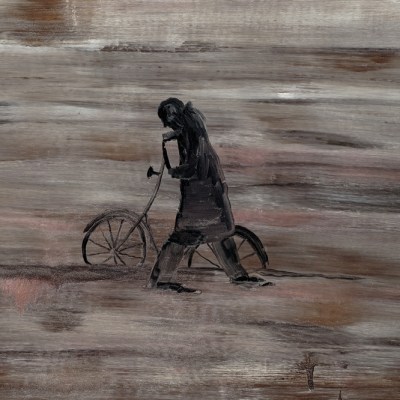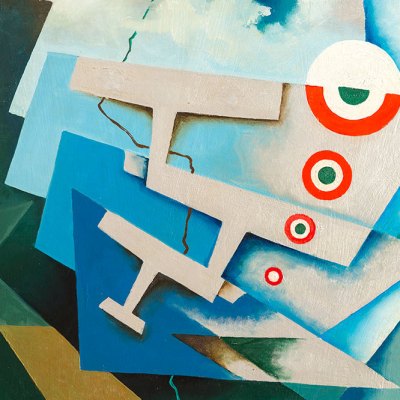Sigmar Polke’s 1968 self-portrait Polke as Astronaut sums up a lot about his approach to making art. The background is part Soviet propaganda and part capitalist kid’s wallpaper: an irregularly repeating pattern of Earths, each lassoed by the scarlet lifeline stretching between an astronaut and his shuttle. The astronauts, bigger than their vessels, bigger than their Earths, natty in red gloves, boot, and visors, are all Polkes, out on a private space walk. But, bigger than all of them is another Polke still: a black, thick-necked bulb looming across the centre of the canvas. It is as schematic a face as you can imagine, and yet it is an unmistakable likeness for Polke himself. Vast, friendly, square-eyed, grinning, his self-portrait pushes itself up into the cosmos looking, above all, happy to be there.
Polke as Astronaut is not on display in ‘Objects: Real and Imagined’, but that exploratory gaze and that grin preside over all the work gathered for the show (the work is a promised gift from a private collection to the San Francisco Museum of Modern Art). Focusing on the period from 1967–69 – directly after Polke’s studies at the Düsseldorf Arts Academy – the 36 pieces brought together at the Michael Werner Gallery all in one way or another echo the sense of an artist floating happily through the universe, just seeing what he can do with it.
Expanding the Planetary System with a 10th Planet (1968), Sigmar Polke. Courtesy Michael Werner Gallery, New York and London; © The Estate of Sigmar Polke, Cologne/ARS, New York/VG Bild-Kunst, Bonn
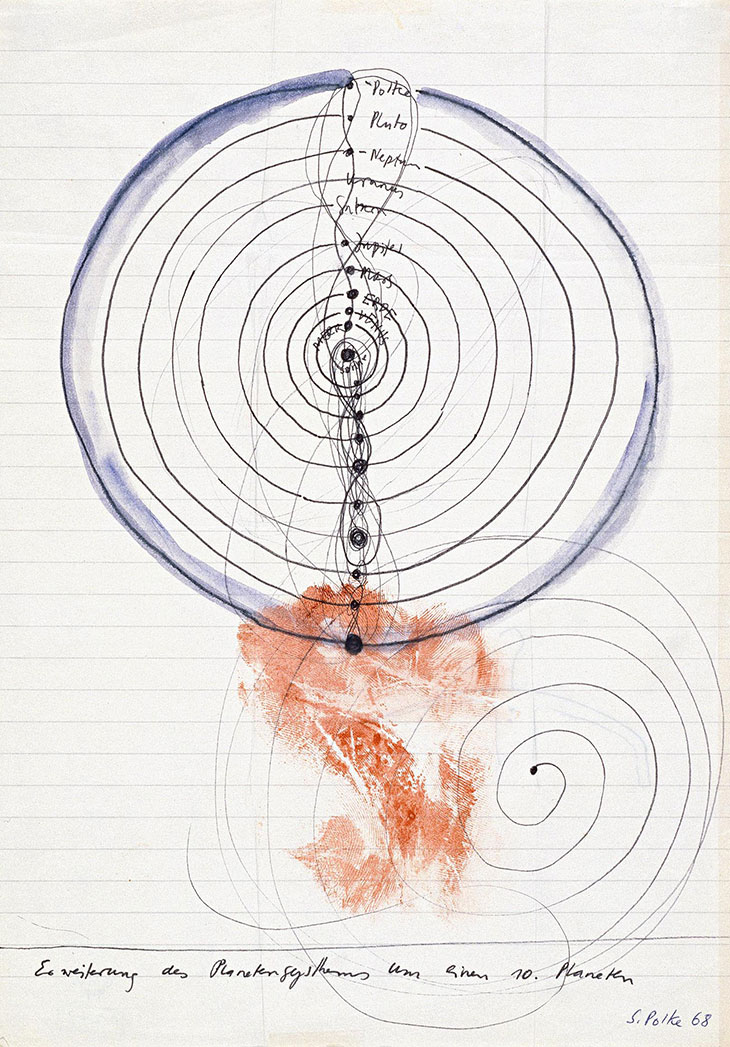
This can seem a little aimless. Take the small drawings displayed here: often messily scribbled on small sheets of lined or squared notepaper, they plot a series of gnomic situations, plans, or putative inventions that run from slug-like abstractions of plaster and glass to a hill cut in half, via beermat fountains and a musical tree. It is scattershot stuff but they do hang together – just about – as a set of explorations of the artist’s place in and out of this world.
The exploratory theme emerges with clarity in a number of the pieces here. On a lined page torn from a notebook, marked with casual carelessness by a partial print of a red-paint-stained hand, Polke proposes Expanding the Planetary System with a 10th Planet (1968). Look at the small labels by the planetary dots in their scrawled concentric rings, and you can see it, one step beyond Pluto: the planet ‘Polke’. In another putative piece, carefully planned in two drawings here, the scale is reversed. The proposal from c. 1968 consists of a single room, ‘R’, containing a person, ‘P’, imagining a particle, ‘Qu’, invisibly orbiting beyond the wall. Perhaps in case this should seem overly abstract or impractical, Polke has noted on one of the plans, ‘R = Raum (warum nicht Galerie Block?)’ (‘R = Room (why not Galerie Block?)’). Why not?
Fountain, Beer Coaster (c. 1967–68), Sigmar Polke. Courtesy Michael Werner Gallery, New York and London; © The Estate of Sigmar Polke, Cologne/ARS, New York/VG Bild-Kunst, Bonn
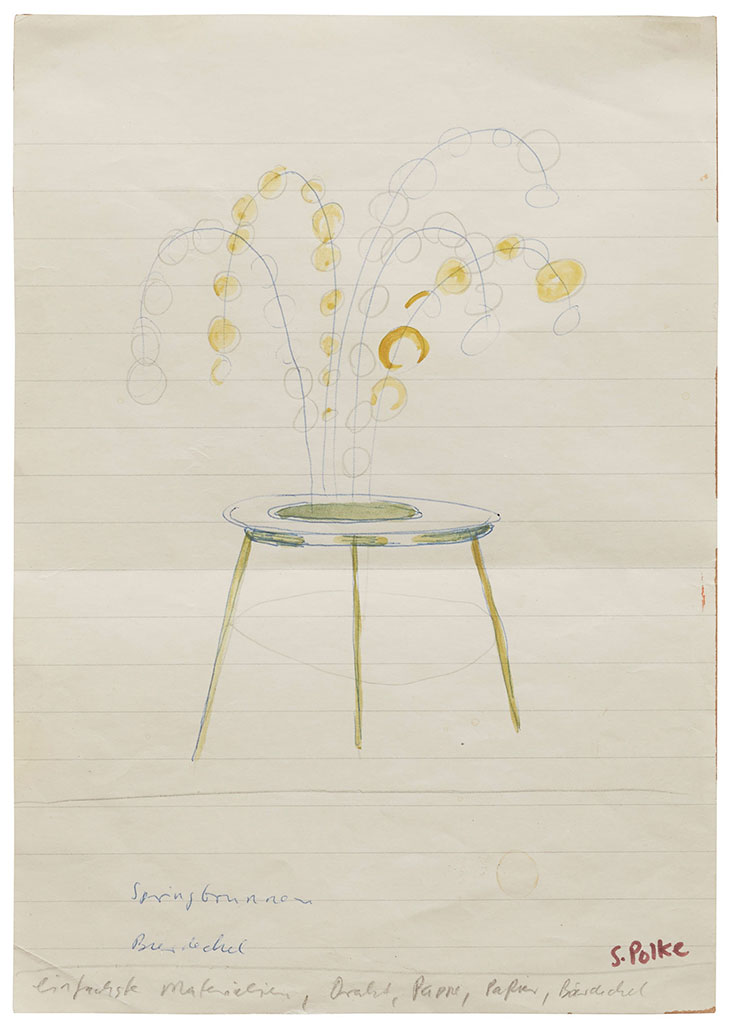
Indeed, though ‘Objects: Real and Imagined’ works well enough as a title, that ‘why not’ is this show’s real epigraph. Much here seems to be a case of Polke arriving at an idea, and seeing no particular reason not to give it a crack. He returns to the idea of the orbit in the realised mechanism of the Potato Machine – Apparatus Whereby One Potato Can Orbit Another (1969), which centres on a repurposed barstool. You can imagine where Polke was and what he was doing when the idea struck him. It was presumably while sitting on similar stools that he imagined the three ‘beer coaster fountains’ sketched out in 1967 or ’68. There are serious things going on here – beer as a metonym of German identity, a series of gags on roots and rootedness, gravity and flight, and so on – but you suspect that to invest in them too heavily would be missing the point. Or perhaps less the point than the initial motivation: a smiling shrug that this or that seemed like a good idea at the time, and, on that account alone, is worth preserving.
Potato Head (c. 1963–65), Sigmar Polke. Courtesy Michael Werner Gallery, New York and London; © The Estate of Sigmar Polke, Cologne/ARS, New York/VG Bild-Kunst, Bonn

This is by no means a criticism, though. Polke’s well-known career-long restlessness, which drove him to produce a vast body of work across media, appears here as a relaxed willingness to try things out, and see what happens. Much of it is silly, though bolstered by a kind of mystical mock seriousness. One intriguing sketch appears to be a plan for a sculpture consisting of Glass Cubes: Higher Powers: Paper made from Paper… (c. 1968); another proposes the creation of The Composing Tree […] (c. 1968), by inserting a microphone into the trunk of a tree and discovering what you can hear. The artist is busy doing things, and what exactly they are for does not need to be settled on too firmly – Polke seems to be working in the faith that purpose or effect will simply appear in due course. One drawing is a roughly pencilled spiral, entirely unremarkable except for the accident of a kidney-shaped blotch. Ringed in pen, marked out with an arrow, the blotch comes with a note in German. Translated, it reads: ‘This stain appeared much later on the paper. But it has lent the unintended effect to the drawing.’
The effect, intended or not, is central. As I stood inside Object Potato House (1967) – a trellised hut, meticulously adorned with a potato at every node – making notes under the watchful eye of a gallery attendant, the ridiculousness of the situation struck me with real pleasure. Of course, not everyone will feel the quite the same way. Whimsy is not always charming; and Polke sceptics are unlikely to be convinced by work so heavy in it. But I suspect Polke would have smiled and shrugged at that too. For those of us happy to follow his orbit for a little while, it is a fun ride.
Installation view of Object Potato House (1967/1990), Sigmar Polke. Courtesy Michael Werner Gallery, New York and London; © The Estate of Sigmar Polke, Cologne/ARS, New York/VG Bild-Kunst, Bonn
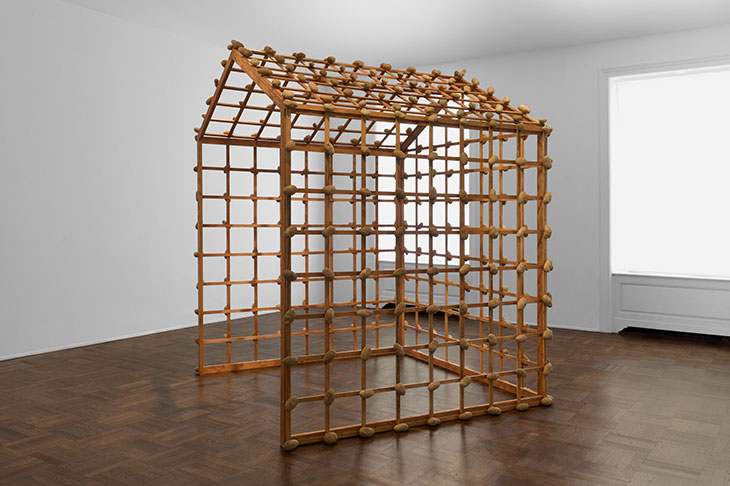
‘Sigmar Polke. Objects: Real and Imagined’ is at Michael Werner Gallery, London, until 21 March.

